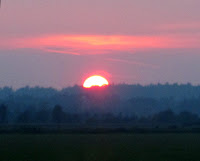 As mentioned in earlier posts, I read a book about a guy who paddled down the entire Mississippi River in a canoe. That inspired a daydream to one day paddle in Ebey Slough just east of Everett Washington.
As mentioned in earlier posts, I read a book about a guy who paddled down the entire Mississippi River in a canoe. That inspired a daydream to one day paddle in Ebey Slough just east of Everett Washington. I put the canoe on top of the truck, tied it down and headed east on the Highway 2 bridge over the Snohomish River a couple of miles. That portion of Highway 2 is called "the trestle." The viaduct and bridge are used by more than 37,000 vehicles everyday.
I put the canoe on top of the truck, tied it down and headed east on the Highway 2 bridge over the Snohomish River a couple of miles. That portion of Highway 2 is called "the trestle." The viaduct and bridge are used by more than 37,000 vehicles everyday.  In the early 1980s I myself had defended a guy named Charles Long who, on this very same Ebey Island, repeatedly stabbed a guy named Freeman with a knife-- partially severing his jugular vein, collapsing a lung and lacerating his heart-- in the presence of two witnesses. As I was searching for one of the eyewitnesses, the deputy prosecutor found the witness and literally had her hypnotized so she could no longer support Long's claim of self-defense. After the jury convicted Long, I got the verdict overturned on appeal in State v. Long, 32 Wn.App. 732 (1982).
In the early 1980s I myself had defended a guy named Charles Long who, on this very same Ebey Island, repeatedly stabbed a guy named Freeman with a knife-- partially severing his jugular vein, collapsing a lung and lacerating his heart-- in the presence of two witnesses. As I was searching for one of the eyewitnesses, the deputy prosecutor found the witness and literally had her hypnotized so she could no longer support Long's claim of self-defense. After the jury convicted Long, I got the verdict overturned on appeal in State v. Long, 32 Wn.App. 732 (1982).  Ebey Island is named for Colonel Isaac Neff Ebey (1818–1857), one of the earliest settlers in the Pacific Nortwest. Col. Ebey was the first permanent white resident on Whidbey Island. In 1857, a party of Haida and Tlingits from British Columbia travelled by canoe into Puget Sound on a mission of vengeance. Following the murder of one of their chiefs by white men the previous year, the Haida party was searching for a white chief to kill in retaliation. The original intended victim was Dr. John Kellogg. But when the Haida were unable to locate Kellogg, they went to Ebey's house, called him out, shot him dead, and beheaded him. Three years after the killing, Isaac Ebey's scalp was recovered by Captain Charles Dodd of the Hudson's Bay Company and given to Ebey's brother. Cpt. Dodd traded the scalp for the price of "Six Blankets, 3 pipes, 1 cotton handkerchief, 6 heads of Tobacco, 1 fthm. Cotton". http://en.wikipedia.org/wiki/Isaac_N._Ebey
Ebey Island is named for Colonel Isaac Neff Ebey (1818–1857), one of the earliest settlers in the Pacific Nortwest. Col. Ebey was the first permanent white resident on Whidbey Island. In 1857, a party of Haida and Tlingits from British Columbia travelled by canoe into Puget Sound on a mission of vengeance. Following the murder of one of their chiefs by white men the previous year, the Haida party was searching for a white chief to kill in retaliation. The original intended victim was Dr. John Kellogg. But when the Haida were unable to locate Kellogg, they went to Ebey's house, called him out, shot him dead, and beheaded him. Three years after the killing, Isaac Ebey's scalp was recovered by Captain Charles Dodd of the Hudson's Bay Company and given to Ebey's brother. Cpt. Dodd traded the scalp for the price of "Six Blankets, 3 pipes, 1 cotton handkerchief, 6 heads of Tobacco, 1 fthm. Cotton". http://en.wikipedia.org/wiki/Isaac_N._Ebey










I'm not entirely sure what I think and feel now about Ebey Slough. But I am truly thankful I got a chance to outlive this particular dream. Next canoe trip-- another peaceful neighborhood lake.













































